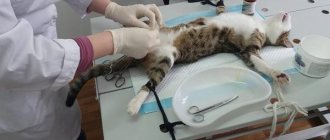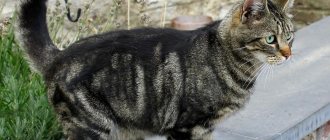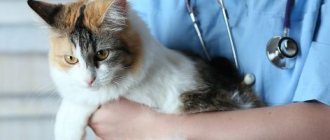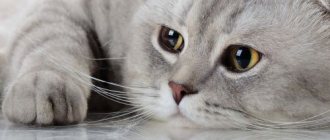18029Pavel
1
When getting a four-legged friend of the Scottish Fold breed, which has a cute appearance and a pleasant character, a person, as a rule, is not going to breed these cats. For this reason, the question naturally arises of when to castrate a Scottish Fold cat.
There is no need to delay castration. If this operation is not carried out, the pet, having matured, will begin to mark everything around and will suffer at the moment of special excitement due to the inability to satisfy its natural need.
Taking this into account, when keeping a cat at home (not in a breeding nursery), castration is a necessary action . Owners should castrate fold-eared cats in a reliable clinic staffed by experienced veterinarians.
© shutterstock
Reasons for castration and minimum age
There are the following reasons why a kitten should be neutered:
- A cat that has reached sexual maturity will begin to demand a cat several times a year. In this case, the animal will meow loudly and may show aggression.
- A cat that is not spayed on time will mark its territory to avoid other cats, even if it is the only animal in the house. The tags have a strong, unpleasant odor and are difficult to remove from clothing, shoes and upholstered furniture. They can eat into carpets and floors.
A Scottish Fold kitten is ready for sterilization at 10 months. Before surgery, it is important to take your pet to a veterinarian so that he can assess how quickly the animal is developing and whether it is ready for sterilization.
Why is the procedure needed?
Sterilization and castration are carried out to normalize hormonal levels in those pets whose sexual needs cannot be satisfied naturally.
There are two types of indications for surgery: medical and behavioral. An indication for surgery may be the behavior of the animal:
- the cat constantly marks the territory, after which a pungent smell of urine remains;
- the pet is aggressive, rushes at people;
- During estrus, the cat suffers, screams loudly, and cannot find a place for itself.
If it is not possible to regularly satisfy your pet’s sexual needs, then it is better to undergo surgery. After it, the animal will stop suffering from dissatisfaction and will become much calmer and more affectionate. After castration, cats stop marking, and their urine loses its pungent odor.
Medical indications are primarily related to the fact that hormonal imbalances can lead to many diseases in pets:
- Oncological diseases. Cats may develop cancer of the mammary glands, ovaries and other genital organs. In cats, prostate cancer comes to the fore.
- Pathology of the genitourinary system. This category includes urethritis, prostatitis and other inflammatory and infectious diseases. In addition, it has been scientifically proven that this surgical intervention increases the life expectancy of the pet.
- Stop marking the territory;
- Disappearance of the too strong smell of urine;
- Lack of desire to run away from home;
- Stopping aggressive behavior and maintaining a playful nature;
- Increased life expectancy;
- Prevention of prostatitis, prostate tumors, etc.
It is important to note that before performing the operation, the doctor must conduct a general clinical examination of the animal. The cat must be in excellent health and feel great. The cat owner must hide food 8-12 hours before the operation to avoid aspiration and vomiting under the influence of anesthesia, and also not give food for one hour in advance. Your consultant doctor will tell you more about the fasting diet when you sign up for castration.
- Administration of anesthesia (intravenously, often intramuscularly);
- Preparation of the “operation field”;
- Making two or one small incisions in the skin of the scrotum;
- Ligation of the spermatic cords;
- Removal of testes;
- Treating the stump with antiseptics;
- Administration of standard medications (antibiotic, hemostatic).
We suggest you read: Can cats eat salt?
The operation does not require stitches and is carried out very quickly. The entire procedure will take 15 minutes.
You can choose the option of castration, when the cat sleeps for 3-4 hours (classic option of castration). At the same time, the cat should not eat on this day, and water can be given only 5 hours after the doctor leaves.
There is a more pleasant option of castration, when the cat comes to his senses already in front of the doctor and even goes to accompany the doctor to the doorstep, controlling his body quite well (which is excluded in the classic version). In this option, you are allowed to eat after 2 hours and drink immediately.
If you wish, you can purchase a cat collar from the doctor, which can be worn for the first 2-3 days to prevent the cat from licking the wound.
Immediately after castration, the food does not change, and the cat eats as before, with its usual food. It is recommended to switch to castrated food 3-4 weeks after neutering. When feeding castrated cats, you should follow a special diet that excludes the consumption of fish dishes.
During the healing period of the wound, all you will need from you is affection and care for the recovering person. This will cheer him up and speed up his return to a healthy lifestyle. Castration of fold-eared cats will not only provide moral peace of mind to the owner, but also significantly improve the quality and length of life of the animal itself.
General nuances
The most popular methods of castration are vasectomy and surgery. In the first case, the veterinarian will tighten the animal's vas deferens. As a result, it will be sterile, but will still be able to leave marks. In the second case, the pet's testicles will be removed. This will result in him never asking for the cat or marking his territory again.
It is worth considering one more nuance before taking your pet for castration - the animal must be sterilized before its first mating occurs. If it was already there, sex hormones will not stop being produced even after the operation. In this case, the cat will still demand the cat.
Preparing the animal
Castration can be carried out only after examining the pet. Blood and urine tests must be taken from your Scottish Fold before surgery. It is also necessary to do an x-ray and ultrasound of the abdominal organs. Elderly animals should be shown to a veterinarian-cardiologist before castration to rule out heart pathologies.
Contraindications for surgery:
- estrus - 10 days must pass after its end;
- exacerbation of chronic diseases;
- lack of necessary vaccinations;
- signs of an infectious disease;
- presence of parasitic infestations.
8 hours before castration, the Scottish cat stops feeding, 3 hours before the intervention - water. It is advisable to perform the operation in the morning so that the owner has the opportunity to provide good care for the cat during the day.
Attention! A day or two before castration, you should not give your cat any medications without the permission of a veterinarian. Some drugs can affect blood clotting, leading to significant blood loss during surgery.
Features of castration at different ages
If the operation is performed before 10 months, complications may arise that can cause diseases: bladder and kidney diseases. The reason is that a kitten’s urethra is fully formed only by 10 months. Due to early sterilization, it will not have time to develop. As a result, the consequences of castration will include urethral obstruction.
It is also worth considering that early castration has a bad effect on the development of a cat. It will be smaller in size than its counterparts who did not undergo surgery. In the case of the Scottish breed, it is important to be careful because spaying too early can distort the animal's proportions and make its head disproportionately small.
You should not castrate cats older than 3 years, because at this age the risk of complications is higher. Internal bleeding may begin. In addition, the metabolism of adult animals is slower than that of kittens, and after surgery, the metabolic rate will decrease even more and lead to obesity.
Kittens at 10-12 months can be operated on under local anesthesia. An adult animal will need a general one, and this is harmful to the pet’s health.
Features of caring for a cat after surgery
After sterilization has been carried out, you should carefully monitor your pet in the first 6 days after it . Caring for wounds after surgery is not required, you just need to carefully monitor your pet so that he does not lick them. Despite the fact that complications almost never occur, the possibility of suppuration cannot be completely ruled out (in this case, you need to contact a veterinarian). On the first day, there should be no water available to the animal, as there is a risk that after undergoing anesthesia the cat will faint and drown, falling with its face into the drinking bowl. You can only give him water under supervision.
© shutterstock
Scottish straight cat pregnancy
So, how do you understand that pregnancy has taken place?
- Like humans, a pregnant cat suffers from toxicosis. Which means she must be sick.
- Pregnancy of a Scottish Straight cat also affects eating habits. The appetite becomes stronger. Food preferences may well change.
- Long sleep becomes the norm. The character changes towards apathy.
- The nipples become larger and pinker.
- The animal naturally becomes fatter. But this becomes noticeable no earlier than the 6th week.
As for the duration of an interesting situation, it is, of course, different and individual. On average, the duration is 60-65 days, sometimes 72 days. However, it all depends on many factors:
- The weight of cats - large individuals are prone to overbearing. Miniature ladies weighing up to 3 kg, as a rule, give birth earlier.
- Age - so, if the owners did not listen to the recommendations and brought the pet earlier than a year, her unprepared body may give birth too early. In this case, the offspring very often do not survive.
- Number of offspring - the more fruits, the faster the expectant mother will give birth.
- The cat's health - for example, infection can cause prematurity and miscarriage.
However, a lot also depends on the behavior of the owner. So what not to do:
- Provide feeding according to the principle “I will give you what I eat.” Even with pets in their normal state, it is undesirable to do this, because not all the food we like suits them. A pregnant cat needs special care, which necessarily includes a balanced, healthy diet.
- Change your diet suddenly. This procedure is stressful for the animal, which a pregnant cat does not need at all. Therefore, if your pet ate natural food before pregnancy, it should be left on the menu.
- Perform palpation. Of course, this method will allow you to determine pregnancy much faster and more accurately than indirect signs. However, this procedure is fraught with great risks, and breeders do not advise amateurs to carry it out.
- Expose yourself to stress. When experienced breeders care for a pregnant cat, they make sure to provide her with calm living conditions. Moving, contacting new people, even rearranging furniture - all this should be postponed for another time.
- Allow walking outside. Fresh air is, of course, wonderful, but it is better to let the cat out on the balcony. Outside the apartment, the chances of catching worms, fleas, ticks or a virus increase significantly.
- Allow jumping - even if the cat was previously graceful and agile, do not forget that pregnancy directly affects coordination.
How is surgery performed?
Despite the fact that the operation is considered simple, it is performed under general anesthesia. With this, it is possible to completely relieve the cat from pain both during and after surgery. First, the pet is given a sedative and then anesthetized. Then the veterinarian proceeds directly to the operation, following the following algorithm of actions:
- Prepares the intervention area.
- Makes incisions on the skin of the scrotum in 2 places.
- Places clamps on the spermatic cords.
- Removes the testicles.
- If necessary, apply stitches.
- Treats the surgical area with an antiseptic solution.
- Administers antibacterial and hemostatic medications.
- Brings your pet out of anesthesia.
- Hands over the Scottish Fold cat to his owners.
For females, the best option for the procedure is to remove the uterus and ovaries at the same time.
If it is necessary to sterilize a cat, it is preferable to remove the ovaries and uterus. This intervention is called ovariohysterectomy. Veterinarians consider this method the most effective for preventing pregnancy. However, there is an easier surgical technique called oophorectomy. During this procedure, only the ovaries are removed.
Choosing the right doctor is half the success
No matter how simple the castration procedure may seem, it must be carried out by a competent doctor. The Good Doctor veterinary clinic in Moscow has at its disposal everything you need for safe castration:
- We employ only qualified doctors;
- a full set of diagnostic equipment;
- possibility of observing the animal in a hospital.
If necessary, we can offer a doctor to visit your home in Moscow and the Moscow region. The cost of castration of a fold-eared cat depends on the state of his health. The price of castration or sterilization of a Scottish cat also depends on the method of performing the operation. Check prices when visiting the clinic: final and complete information can only be obtained after examining the animal.
What vaccinations are given to kittens, cost
Small, helpless kittens receive the first antibodies that increase immunity along with the mother's cat's milk. After weaning, instead of colostrum, the baby needs additional protection of the body from viruses and bacteria. At the age of 8-10 weeks, vaccinations are required for Scottish kittens. Before the first vaccinations are carried out, the kitten is prepared and the body is prevented from worms.
Depending on the conditions of detention and lifestyle, the first vaccination for a Scot contains:
- a vaccine against herpesvirus, calicivirus, panleukopenia and rabies, even if the animal leads a permanent home lifestyle;
- They also vaccinate against viral leukemia and chlamydia if the kitten lives in a private house, in a country house and leaves the house where it has likely contact with other animals;
Vaccinations for fold-eared kittens, as well as straight-eared Scots, are performed in accordance with the following scheme:
- At 2 months, the full range of vaccinations with the exception of the rabies vaccine;
- At 3 months, revaccination is carried out with the same complex of drugs with the addition of rabies vaccine.
- Every year and beyond, as the child grows, the entire vaccination package is repeated, including the anti-rabies drug.
The cost of vaccination depends on the price of the drug and factors of the procedure in different regions of the country and consists of:
- from the cost of the most common complex of drugs: Purevax RCPCh + Rabizin + Nobivac Rabies;
- prices for issuing a veterinary passport;
- payment for the work of a veterinarian;
- payment for calling a doctor to your home.
Adults (what vaccinations are given to adults + cost)
Vaccinations for adult cats and Scottish cats have the following advantages:
- they support the immunity of animals to environmental living conditions.
- Vaccinated pets develop a persistent, throughout the year, resistance to serious diseases;
- The vaccinated animal is protected itself and the owner is guaranteed protection, for example, from rabies;
- The occurrence of some infectious processes in a mild form
- When walking in nature and interacting with other animals, the risk of your pet contracting an infection is reduced to a minimum.
Throughout life, the vaccination procedure is repeated annually, preferably in the same month of the year. They make sure that the animal is dewormed on time, is healthy, and that the cat is not pregnant or nursing cubs.
The basic composition and cost are similar to vaccination for kittens, depending on the region and other factors.











